Abstract
Suppose ai indicates the number of orbits of size i in graph G. A new counting polynomial, namely an orbit polynomial, is defined as OG(x) = ∑i aixi. Its modified version is obtained by subtracting the orbit polynomial from 1. In the present paper, we studied the conditions under which an integer polynomial can arise as an orbit polynomial of a graph. Additionally, we surveyed graphs with a small number of orbits and characterized several classes of graphs with respect to their orbit polynomials.
1. Introduction
By having the orbits and their structures in a graph, we can infer many algebraic properties about the automorphism group and thus about the similar vertices. For example, the length of orbits of a network gives provides important information about each individual component in the network. In other words, all vertices in an orbit have the same properties such as the degree of vertices which yield useful data about the number of components’ interconnections. Finding the counting polynomial [] of a graph often helps to investigate the structural properties regarding the graph.
Hosoya was the first chemist that introduced the Hosoya counting polynomial (C-polynomial) [] and other well-known C-polynomials that have been defined to date, which can be found in references [,,,,] as well as [,,,].
One of the important polynomials, as recently defined by Dehmer et al. [], is the orbit polynomial that uses the cardinalities of the vertex orbit sizes. In the definition of an orbit polynomial, which is , c is the number of orbits of graph G of size n. The coefficients of this polynomial are all positive, so subtracting this polynomial from 1 results in the new polyomial that has a unique positive root, as can be seen [,,,,,,]. It is possible to define the orbit polynomial for general cases of a graph such as weighted graphs. For instance, for a graph with multiple edges or for a hetero molecule in which an atom is replaced by another, the orbit polynomial can be calculated, as can be seen in [].
Additionally, in [], some bounds for the unique and positive zero of were computed. The authors indicated that the unique positive root of this new polynomial can be served as a relative measure of a graph’s symmetry. The magnitude of this root measures symmetry and can therefore be used to compare graphs with respect to this property. Finally, it is shown that this measure can be quite useful for tackling applications in chemistry, bioinformatics, and structure-oriented drug design. In [], the structural attributes of the automorphism group of a graph were investigated, and then the orbit polynomial of some graph operations were computed. Moreover, the degeneracy of an orbit polynomial is compared with a new counting polynomial. In [], several properties of orbit polynomial with respect to the stabilizer elements of each vertex and many classes of graphs with a small number of orbits were studied. This method was applied to investigate the symmetry structure of some real-world networks. The main contribution of this text was to construct graphs with a given integer polynomial as its orbit polynomial. We proceed as follows. Section 2 outlines the concepts and definitions that will be used in this paper. In Section 3, we survey some well-known results about the orbit polynomial. In Section 4, we construct graphs whose orbit polynomials are integer and we show that there is a one-to-one correspondence with the number of partitions of an integer n and the number of distinct orbit polynomials of a graph of order n.
2. Preliminaries
The notations of the current work are standard, for example, as can be seen in []. The vertex and edge sets of a graph G are denoted by and , respectively. We only considered simple and connected graphs. The orbit polynomial is based on two concepts: the automorphism group and the vertex orbits.
Consider the automorphism group of graph G. Then, for each vertex , the set is called an orbit of G containing v. A vertex-transitive graph is a graph with exactly one orbit and an edge-transitive graph is a graph that is transitive on the set of edges.
The action of group on the set X induces a group homomorphism from into the symmetric group on X, where for all and . For a vertex , the set is called the stabilizer of v. Then, by the orbit-stabilizer theorem, it holds that .
The vertex orbits, under the action of automorphisms on the set of vertices, constitutes a partition which captures the symmetry structure of the graph, as can be seen in [,,,,,,]. In a complex network, the collections of similar vertices can be used to define communities with shared attributes, as can be seen in [].
In this paper, the two symbols and denote a star graph on n vertices and a bi-star graph on vertices, respectively. In addition, the graph is a tree which has a central vertex of degree n adjacent with n vertices of degree each of them is adjacent to m pendant vertices.
3. Methods and Results
The orbits of a graph show vertices with similar properties such as having the same degree or the same eccentricity. Conversely, if there exists a property that does not hold for two vertices, then these vertices are not in the same orbit. Thus, creating several kinds of polynomials on the set of orbits of a graph may facilitate distinguishing vertices with different properties and thus breaking them up into distinct orbits.
3.1. Orbit Polynomial
Supposing are all orbits of G. Then, the orbit polynomial and the modified orbit polynomial [] are defined as
From the definition, it is clear that if G is a graph with an identity automorphism group, then or equivalently . Additionally, a graph is only vertex transitive if , and only if . This means that if G and H are two vertex-transitive graphs of the same order, then they have the same orbit polynomials and thus the orbit polynomial cannot capture symmetrical information about a vertex-transitive graph, as can be seen in [].
In algebraic graph theory, characterizing graphs in terms of polynomials such as a characteristic polynomial, independence polynomial, and matching polynomial is always an important problem. Here, we characterize several classes of trees in terms of their orbit polynomial.
Theorem 1.
Ref. [] Let T be a tree on n vertices. Then:
- if and only if .
- if and only if .
- if and only if , where .
Definition 1.
Let be all edge orbits of . Thenan edge-orbit and the modified edge-orbit polynomials are defined as
Theorem 2.
Ref. [] For the edge-orbit polynomial, we obtain if and only if .
As an application, in [] it was also proven that the cycle graph can be characterized by the edge version of the orbit polynomial.
3.2. Graph Classification with Respect to Orbit Polynomial
Following the methods of [], in this section we introduce several classes of graphs that can be characterized by their orbit polynomials. If G is a graph with , then clearly and, in general, if G has n vertices and , then G is has no non-identity automorphism. This means that G is asymmetric. For a graph with two vertices, it is clear that or and thus . Suppose G is a graph with three vertices. Then or or . There is no graph of order 3 with , since the smallest graph in the identity automorphism group has at least six vertices, as can be seen in []. Graphs with are and its complement and graphs with the orbit polynomial are and .
There are 11 graphs of order 4 as given in Figure 1. Their orbit polynomials are among the following polynomials: or or or . According to the above discussion, there is no graph with . In addition, there are two graphs with , four graphs with , two graphs with and three graphs with as given in Figure 1.
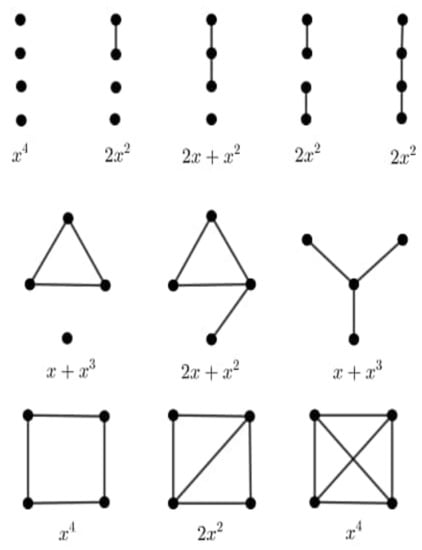
Figure 1.
All graphs of order 4.
For a graph G of order n, there is a one-to-one correspondence between the possible distinct orbit polynomials and the number of partitions of integer n. For example, if , then there are three partitions and and for integer 3 and thus three polynomials , and that can be arisen as orbit polynomials. Since there is no graph of order 3 with the identity automorphism group, all graphs of order 3 have either or as an orbit polynomial. This means that for a graph of order n, there are at most distinct orbit polynomials. As a result, there are at most 11 distinct polynomials that can be the orbit polynomials of a graph of order 6, since . The partitions and correspondence polynomials are reported in Table 1.

Table 1.
The partitions and orbit polynomials of all graphs of order 6.
Here, we characterize graphs with respect to their orbit polynomials.
Example 1.
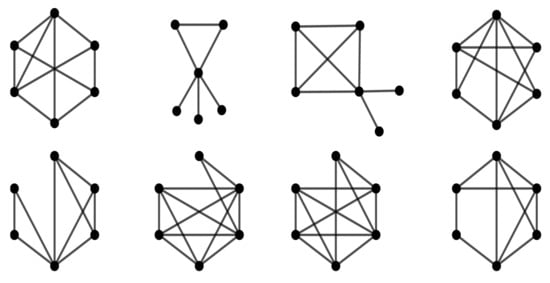
In Figure 2, all members of the class of graphs on six vertices with the orbit polynomial are depicted. They are not isomorphic and have different automorphism groups.

Figure 2.
All graphs on six vertices with the orbit polynomial .
In the next theorem, by , we mean a graph obtained from the complete graph by attaching r pendant edges at a common vertex.
Theorem 3.
Suppose G is a graph with . If G has at least a pendant edge, then or .
Proof.
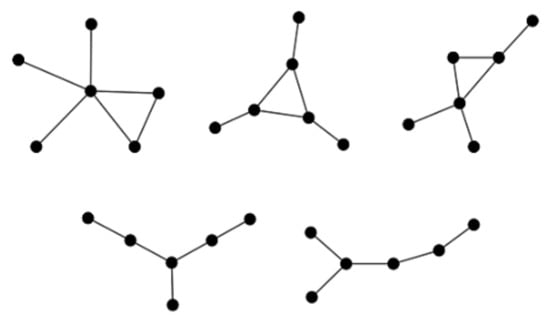
From the definition of an orbit polynomial, we yield that G has 6 vertices. As it has exactly one pendant edge, two different singleton orbits, there is a contradiction. Therefore, we may assume that G has two pendant edges, then two cases hold: the pendant edges share a common vertex and they necessarily compose an orbit of size 2 and the common vertex composes a singleton orbit. Hence, the other vertices together with the singleton vertex lie on a common 4-cycle. Among all cases, only the graph satisfies the above conditions. Supposing that the pendant edges have no vertex in common. If two pendant edges can be imaged to each other, since the supported vertices are also in the same orbit, there are at least two orbits of order 2—which is a contradiction. If there are three pendant edges, then G is isomorphic with one of the graphs depicted in Figure 3. Among them, only satisfies the conditions of theorem. This completes the proof. □

Figure 3.
All graphs on six vertices that have three pendant edges, with the orbit polynomial .
Example 2.
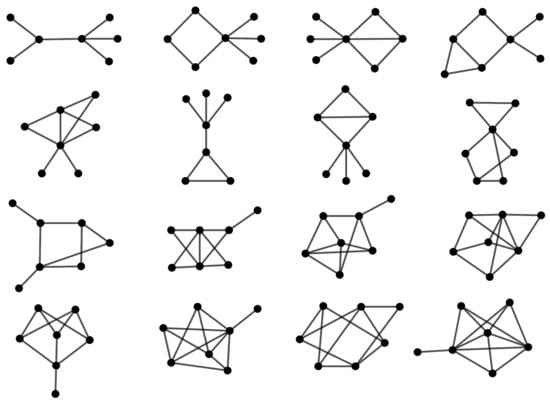
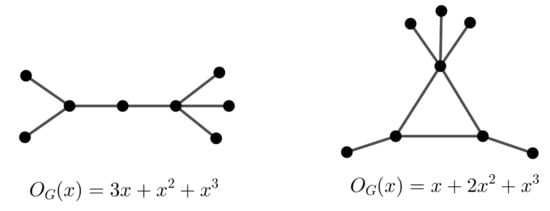
Consider the graph G with n vertices and suppose that and c are three positive integers that . If the orbit polynomial is , then , and thus . In Example 1, the problem is solved for . If , then we obtain and . Hence, . Thus, G has two orbits of size 1, an orbit of size 2 and an orbit of size 3. It can be found that there are 39 graphs for this property and we depicted some of them in Figure 4.

Figure 4.
Examples of graphs of order 7 with the orbit polynomial .
If , then the orbit polynomial of G is either or . Both cases are possible, as can be seen in Figure 5.

Figure 5.
Graphs of order 8 and different orbit sizes.
In general, for a graph with , where , the orbit-stabilizer theorem yields that . On the other hand, since , G has no permutation of order 6. Similarly, G has no permutation of order 4 or 5 and so is a -group. This yields that . It holds that 6 or 12 and thus or or . Since G has not orbit of size 6, we conclude the following theorem.
Theorem 4.
Let G be a graph of order n with the orbit polynomial , where , and c are three positive integers such that . Then, is a -group.
For the automorphism , the the support of g is defined as . Two permutations f and g are said to be disjoint if .
Theorem 5.
Ref. [] Let S be a set of generators of , and . Then
A network G which satisfies Theorem 5 is called locally symmetric. In other words, the network G is locally symmetric if can be factorized into a large number of geometric factors.
For a graph , let be a subset of generators of , then .
Corollary 1.
Let S be a set of generators of , and . Then
where t is the number of singleton sets.
Proof.
The structure of the group shows that the elements of each , can be permuted to itself. Hence, the image of elements in ′s are orbits of . □
Suppose and are finite groups and acts on the set . The wreath product of groups and is a group with the underline set:
The group operation can be defined as , where for any , . For the description of the symmetry of networks, we used the wreath product. For example, suppose is a network constructed from the union of r copies of a graph . Then, .
Consider the graph as depicted in Figure 6. It presents a typical arrangement of symmetric subgraphs found in many real-world networks. The structure of the network automorphism group is completely related to the automorphism group of subgraphs induced by its orbits. In [], the authors determined the structure of the automorphism group of , which is:
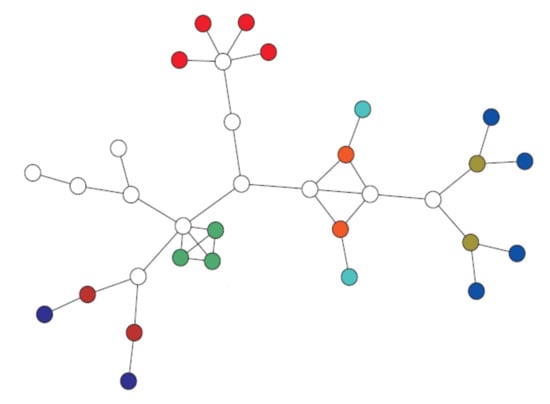
Figure 6.
Vertices with the same colors are in the same orbit and singleton orbits are shown by white colors.
Hence, and .
4. Integer Polynomials
The polynomial is called an integer polynomial of degree n, if its coefficients are non-negative integer numbers. The caterpillar tree is a graph constructed from the path graph by adding leafs to the ith vertex of . Consider the caterpillar graph depicted in Figure 7. Then .
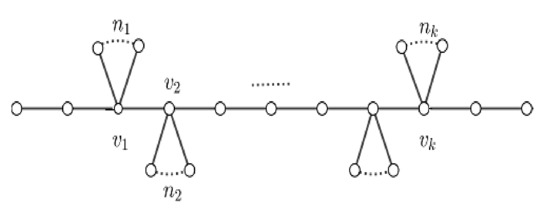
Figure 7.
The caterpillar graph .
It is clear that the orbit polynomial is always a polynomial with integer coefficients, and thus it is an integer polynomial. The aim of this section is to answer the question of whether, supposing is an integer polynomial, where , there is any graph whose orbit polynomial is .
Example 3.
For the caterpillar graph , where , we obtain:
where .
Here, we determine some classes of graphs with the orbit polynomial , where and . If , then and thus all orbits of G have the same order, namely and so . If , then G is the asymmetric graph. For , let , then, the graph obtained from the complete graph by attaching the path graph to each vertex of (as can be seen in Figure 8), is a graph with the orbit polynomial .
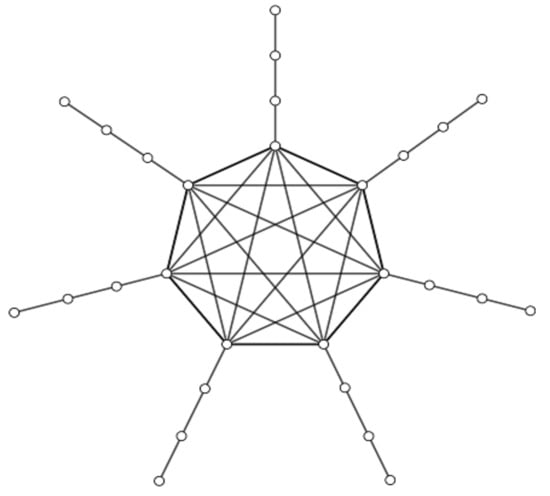
Figure 8.
The graph .
In general, we have the following theorem.
Theorem 6.
Let G be a vertex-transitive graph on n vertices. Then, the orbit polynomial of graph is .
Proof.
It is clear that all vertices of G are in the same orbit. Moreover, the corresponding vertices of each copy of compose orbits of length n. □
Theorem 7.
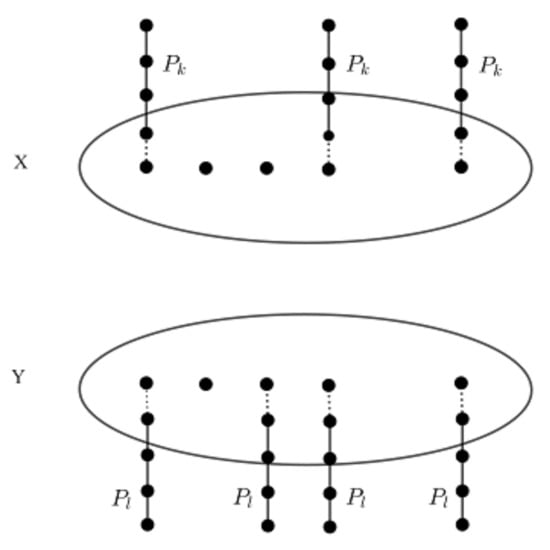
Let G be a graph with two orbits X and Y. Attach to each vertex of X the path graph and to each vertex of Y, the path , as can be seen in Figure 9. Then, the resulting graph has the orbit polynomial .

Figure 9.
The graph .
Proof.
The proof is straightforward. □
Finally, (’s are greater than or equal to zero and at least one of them is not zero) pendent vertices are attached to the ith vertex of . The resulting graph was denoted by , as can be seen in Figure 10. It is not difficult to see that , where .
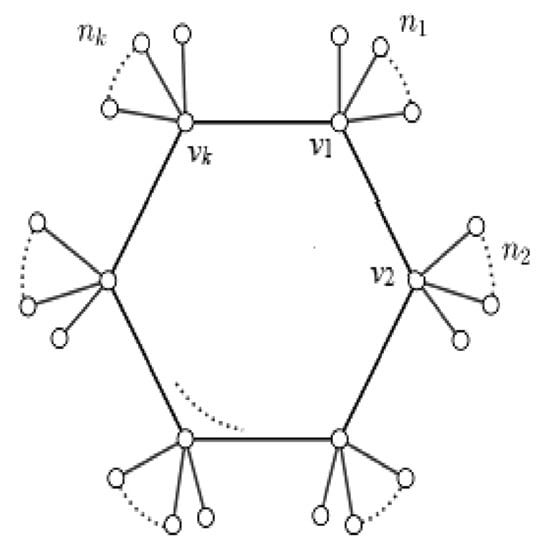
Figure 10.
The graph .
Thus far, we provided examples of graphs with both polynomials () and . Thus, for a given integer polynomial (), two polynomials and are the orbit polynomials of a graph and we conjecture that there is a graph with the orbit polynomial .
5. Summary and Conclusions
In this paper, we investigated the orbit polynomial for several graph/network classes. In addition, we inferred some well-known results about the orbit polynomial. Then, we constructed graphs with a given integer polynomial as its orbit polynomial. The method was applied to investigate the symmetry structure of some real-world networks. Finally, we investigated graphs whose orbit polynomials were integer and we showed that there was a one-to-one correspondence with the number of partitions of an integer n and the number of distinct orbit polynomials of a graph of order n.
Author Contributions
M.G., M.J.-R. and M.D. wrote the paper. All authors have read and agreed to the published version of the manuscript.
Funding
Matthias Dehmer thanks the Austrian Science Funds for supporting this work (project P30031).
Data Availability Statement
The data presented in this study are available on request from corresponding author.
Conflicts of Interest
The authors declare no conflict of interest.
References
- Hosoya, H. On some counting polynomials in chemistry, Applications of graphs in chemistry and physics. Discret. Appl. Math. 1988, 19, 239–257. [Google Scholar] [CrossRef]
- Hosoya, H. Topological index, a newly proposed quantity characterizing the topological nautre of structural isomers of saturated hydrocarbons. Bull. Chem. Soc. Jpn. 1971, 44, 2332–2339. [Google Scholar] [CrossRef]
- Hosoya, H. Clar’s aromatic sextet and sextet polynomial. Top. Curr. Chem. 1990, 153, 255–272. [Google Scholar]
- Farrell, E.J. An introduction to matching polynomials. J. Comb. Theory 1979, 27, 75–86. [Google Scholar]
- Gutman, I.; Harary, F. Generalizations of the matching polynomial. Util. Math. 1983, 24, 97–106. [Google Scholar]
- Stevanović, D.; Motoyama, A.; Hosoya, H. King and domino polynomials for polyomino graphs Graph Theory Notes. J. Math. Phys. 1977, 34, 31–36. [Google Scholar]
- Balasubramanian, K.; Ramaraj, R. Computer generation of king and color polynomials of graphs and lattices and their applications to statistical mechanics. J. Comput. Chem. 1985, 6, 447–454. [Google Scholar]
- Farrell, E.J.; De Matas, C.M. On star polynomials of complements of graphs. Ark. Mat. 1989, 26, 85–190. [Google Scholar] [CrossRef]
- Farrell, E.J.; De Matas, C.M. Star polynomials of some families of graphs with small cyclomatic numbers. Util. Math. 1988, 33, 33–45. [Google Scholar]
- Dong, F.M.; Koh, K.M.; Teo, K.L. Chromatic Polynomials and Chromaticity of Graphs; World Scientific Publishing Co. Pte. Ltd.: Hackensack, NJ, USA, 2005. [Google Scholar]
- Balasubramanian, K. On Graph Theoretical Polynomials in Chemistry. In Mathematical and Computational Concepts in Chemistry; Trinastić, N., Ed.; Ellis Horwood Ltd.: New York, NY, USA, 1986; pp. 20–33. [Google Scholar]
- Dehmer, M.; Chen, Z.; Emmert-Streib, F.; Mowshowitz, A.; Varmuzag, K.; Jodlbauer, H.; Shih, Y.; Tripathi, S.; Tao, J. The orbit-polynomial: A novel measure of symmetry in graphs. IEEE Access 2020, 8, 36100–36112. [Google Scholar] [CrossRef]
- Dehmer, M.; Chen, Z.; Emmert-Streib, F.; Mowshowitz, A.; Shih, Y.; Tripathi, S.; Zhang, Y. Towards detecting structural branching and cyclicity in graphs: A polynomial-based approach. Inf. Sci. 2019, 471, 19–28. [Google Scholar] [CrossRef]
- Dehmer, M.; Shi, Y.; Mowshowitz, A. Discrimination power of graph measures based on complex zeros of the partial Hosoya polynomial. Appl. Math. Comput. 2015, 250, 352–355. [Google Scholar] [CrossRef]
- Dehmer, M.; Ilić, A. Location of zeros of Wiener and distance polynomials. PLoS ONE 2012, 7, e28328. [Google Scholar] [CrossRef]
- Ellis-Monaghan, J.A.; Merino, C. Graph polynomials and their applications I: The Tutte polynomial. In Structural Analysis of Complex Networks; Dehmer, M., Ed.; Birkhäuser: Boston, MA, USA; Basel, Switzerland, 2010; pp. 219–255. [Google Scholar]
- Ghorbani, M.; Dehmer, M.; Cao, S.; Tao, J.; Streib, F. On the zeros of the partial Hosoya polynomial of graphs. Inf. Sci. 2020, 524, 199–215. [Google Scholar] [CrossRef]
- Tikoo, M.L. Location of the zeros of a polynomial. Am. Math. Mon. 1967, 74, 688–690. [Google Scholar] [CrossRef]
- Zilovic, M.S.; Roytman, L.M.; Combettes, P.L.; Swamy, M.N. A bound for the zeros of polynomials. IEEE Trans. Circuits Syst. I 1992, 39, 476–478. [Google Scholar] [CrossRef]
- Trinajstić, N. Chemical Graph Theory; CRC Press: Boca Raton, FL, USA, 1992. [Google Scholar]
- Ghorbani, M.; Dehmer, M.; Emmert-Streib, F. On the degeneracy of the orbit polynomial and related graph polynomials. Symmetry 2020, 12, 1643. [Google Scholar] [CrossRef]
- Ghorbani, M.; Dehmer, M.; Jalali-Rad, M.; Emmert-Streib, F. Analyzing graphs by means of the orbit polynomial. Submitted.
- Harary, F. Graph Theory; Addison-Wesley Publishing Company: Boston, MA, USA, 1969. [Google Scholar]
- Ghorbani, M.; Dehmer, M.; Rajabi-Parsa, M.; Emmert-Streib, F.; Mowshowitz, A. Hosoya entropy of fullerene graph. Appl. Math. Comput. 2019, 352, 88–98. [Google Scholar] [CrossRef]
- Ghorbani, M.; Dehmer, M.; Rajabi-Parsa, M.; Mowshowitz, A.; Emmert-Streib, F. On Properties of Distance-Based Entropies on Fullerene Graphs. Entropy 2019, 21, 482. [Google Scholar] [CrossRef]
- Ghorbani, M.; Dehmer, M.; Mowshowitz, A.; Emmert-Streib, F. The Hosoya entropy of graphs revisited. Symmetry 2019, 11, 1013. [Google Scholar] [CrossRef]
- Mowshowitz, A. Entropy and the complexity of graphs: I. An index of the relative complexity of a graph. Bull. Math. Biophys. 1968, 30, 175–204. [Google Scholar] [CrossRef] [PubMed]
- Mowshowitz, A.; Dehmer, M. The Hosoya entropy of a graph. Entropy 2015, 17, 1054–1062. [Google Scholar] [CrossRef]
- MacArthur, B.D.; Sánchez-García, R.J.; Anderson, J.W. Symmetry in complex networks. Disc. Appl. Math. 2008, 156, 3525–3531. [Google Scholar] [CrossRef]
Publisher’s Note: MDPI stays neutral with regard to jurisdictional claims in published maps and institutional affiliations. |
© 2021 by the authors. Licensee MDPI, Basel, Switzerland. This article is an open access article distributed under the terms and conditions of the Creative Commons Attribution (CC BY) license (https://creativecommons.org/licenses/by/4.0/).